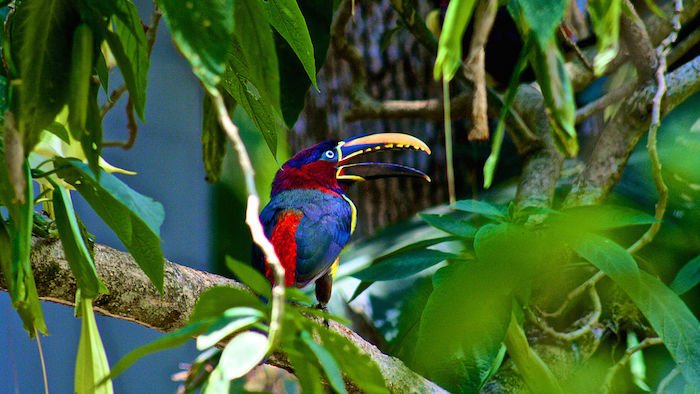Big-Beaked Birds
Tim Sackton from Somerville, MA, CC BY-SA 2.0, via Wikimedia Commons
Ramphastidae
by Inspector Barry Mins on June 13, 2023Hey kids, welcome back to our series on the mysteries of created kinds. We’ve been on a bit of a hiatus as we came to the close of the school year, but we are back now with some very colorful birds.

This week’s bird kind is found in Central America and South America. It is notoriously colorful with a large, bulky bill. Most individuals prefer fleshy fruits, which they either swallow whole or slice open with their beaks before consuming.1 This is true even when they live in urban areas.2 However, a few will eat other, less obvious prey. They are known to occasionally eat caecilians, a type of amphibian.3 They will also dine on some insects. They will frequently favor hopping from branch to branch over flying in search of their food.4
In most species, males and females are either identical or very close. In one genus, and potentially a second, males and females are sexually dimorphic.5 These birds love to nest in hollowed-out sections of trees.6 Both parents provide food for the developing nestlings in the form of insects and fruits.7 The nestlings hatch with a miniature version of the characteristic adult bill, usually with the color pattern already in place.
Has anyone figured it out yet? This week’s kind is the Ramphastidae —the toucan kind. Most people know what a toucan is, but there are multiple species, and not all share the same patterns or colors. Unfortunately for my US readers, there are none this far north. Stay tuned for next week when we meet a globe-trotting group of lizards.
Try out this fun crossword!
Clue
Your clue for the week is:
There are over 550 species in this kind, and they are known for their bright colors. Sometimes they are called . . . dragons. But it is not the Komodo dragon.
Ask a Question
Have you ever had a question about created kinds but didn’t know who to ask? Have you ever wanted to learn more about your favorite kind? Well, now you can! You can ask me, Inspector Barry Mins, a question! Have your parents help you fill out this form, and you might get your question answered in my column! If you have any questions about created kinds, feel free to send them my way!
Footnotes
- Ragusa-Neto, J. “Abundance and Frugivory of the Toco Toucan (Ramphastos toco) in a gallery forest in Brazil’s southern Pantanal.” Brazilian Journal of Biology 66, no. 1A (2006): 133–142. https://www.scielo.br/j/bjb/a/JdHp88gsbCjbGZZNbptmG4r/?format=pdf&lang=en
- Aparecida dos Santos, A., and J. Ragusa-Neto. “Toco-toucan (Ramphastos toco) feeding habits at an urban area in central Brazil.” Ornithologia Neotropical 24, no. 1 (2013): 1–13. https://www.researchgate.net/publication/298565312_TOCO-TOUCAN_RAMPHASTOS_TOCO_FEEDING_HABITS_AT_AN_URBAN_AREA_IN_CENTRAL_BRAZIL
- Solano-Ugalde, A. “The plate-billed toucan (Adigena laminirostris) feeding on a Caecilia spp (Gymnophiona: Amphibia).” Bolentin SAO 20, no. 2 (2011): 43–45. https://sao.org.co/publicaciones/boletinsao/20(2)/NC220(2)Solano.pdf
- Hofling, E., A. Abourachid, and S. Renous. “Locomotion behavior of the lettered aracari (Pteroglossus inscriptus) (Ramphastidae).” Ornithologia Neotropical 17, (2006): 363–371. https://hal.science/hal-02017822/document
- Castro, M. S., S.M. Recco-Pimentel, and G.T. Rocha. “Sexual dimorphism in Ramphastos toco and Ramphastos dicolorus (Piciformes, Aves).” Revista de Biologia Tropical 51, no. 1 (2003). https://www.scielo.sa.cr/scielo.php?pid=S0034-77442003000100022&script=sci_arttext
- Ingels, J. V. Pelletier, and M. Giraud-Audine. “Description of the first nest of Green Aracari (Pteroglossus viridis) for French Guiana.” Boletin SAO 20, no. 2 (2012): 79–82. https://sao.org.co/publicaciones/boletinsao/20(2)/NC620(2)Ingelsetal.pdf
- Sandoval, L. and A. Rodriguez. “Observations at a yellow-eared toucanet (Selenidera spectabilis) nest.” Ornitologia Neotropical 29, (2018): 175–178. https://www.kerwa.ucr.ac.cr/bitstream/handle/10669/88518/Sandoval%20&%20Rodr%C3%ADguez%202018.pdf?sequence=1
- © 2024 Answers in Genesis
- Privacy Policy
- Contact
- About



